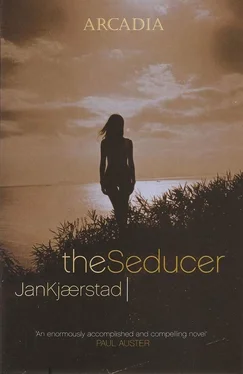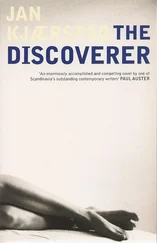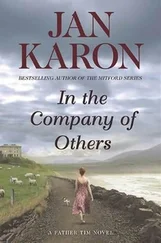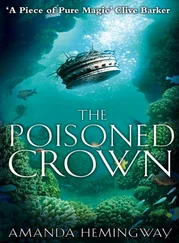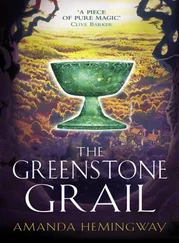Aunt Laura’s flat looked like a bazaar. Where the walls were not covered in oriental rugs they were hung with objects made of copper and brass, and crawling around the floor was a leopard-tortoise with little gems affixed to its shell. Jonas had the feeling that the tortoise was forever going round in circles and that time stood still at Aunt Laura’s.
Apart from Torggata Baths, nowhere in Oslo had a more edifying influence on Jonas Wergeland’s imagination than Aunt Laura’s flat.
To gain a deeper insight into this unique world I would recommend the following experiment: make a cup of tea, preferably one of the rarer varieties, put on ‘Isfahan’ from Duke Ellington’s The Far East Suite and settle back into a pile of soft cushions. Then shut your eyes and listen to the mellow lazy horns of Duke Ellington’s seductive orchestra, inhale the scent of, say, China tea while running your fingers over the cool silk of the cushion covers. Try also to imagine how Billy Strayhorn’s wonderfully languorous melody would sound in a room where the music was muted by an untold number of thick rugs and the sound of hammer-blows on soft precious metals mingled with Johnny Hodges’ haunting saxophone solo. That was Aunt Laura’s flat. Every child has his own Ali Baba’s cave, and this was Jonas’s.
Jonas’s family was blessed with many weird and wonderful characters, and Aunt Laura, his father’s sister, was one of them: with black-lined eyelids and blood-red lipstick in an almost chalk-white face, and a flair for shawls and hats seldom met with in grey ascetic Oslo. All in all, Aunt Laura belonged to that microscopic band of Norwegians who could have stepped straight onto the set of a Fellini film. She had trained as a goldsmith and lived alone in a tenement in Tøyen on the east side of the city. After working initially for a reputable but dull company with showrooms on Karl Johans gate, his aunt had gone into business for herself, setting up a workshop in the flat, at the far end of the living room. And she was doing very nicely; she had built up a devoted clientele who positively outbid one another for the pieces she made, objets d’art which gradually began to acquire the status of cult objects, and provocative ones at that.
When Jonas’s aunt’s work-lamp was not switched on, the room lay bathed in a dim light that opened it up, creating vast distances. The rugs became windows onto evocative shadowy landscapes, and the copper and brass on the walls and the silver on the workbench glowed mysteriously. To Jonas that room seemed transformed into a firmament in which the glints in the metal were stars, and the patterns of the rugs hinted at the tales that lay tucked away within those faint points of light. In this room, Jonas Wergeland was told stories the like of which few other children in Norway would ever hear.
Aunt Laura was a collector, she collected rugs, and in order to track down new rugs she was forever out travelling — so often that she spent more time abroad, particularly in the Middle East and Central Asia, than at home. Jonas’s aunt was an expert on Oriental rugs, one of a tiny handful of people who took a pride in being able to differentiate between a Bergama, a Ghiordes or a Kemurju-Kulah rug and who could give you a complete run-down on the symbolism of the ‘boteh’ motif and all its regional variations at the drop of a hat. She had, however, only one criterion, albeit a most exacting one, when it came to choosing rugs for herself; they had to inspire her.
Jonas was fascinated by those rugs on the walls which, if he turned round quick and only looked at them with half an eye, all looked exactly the same, but which were in reality all quite different just as no two crystals of snow are alike. Jonas remembered the day when he was lying among the pile of soft cushions on the sofa, with a cup of tea to hand, and his aunt — sitting at her workbench behind the hanging drill, the lathe and the saw-frame — first told him about the greatest of all the rug-makers: nomads endowed with such exceptional powers of recall and imagination that they might carry as many as two hundred carpet designs in their heads, down to the smallest detail, and these they would sing out, knot by knot, to the rug-knotters in village after village. ‘Actually they were a bit like your grandfather,’ his aunt said.
For Jonas, the greatest revelation came when Aunt Laura put down her work, positioned herself next to one of the rugs — rather like his geography teacher when he pulled down one of the big maps in the classroom — and showed him how each rug could contain a story, a legend and sometimes more than one, all of which she recounted while pointing out the different features of each rug. It was not only the technique involved that left Jonas all agog, the idea that even the simplest story could be made up of millions of knots, thus saying something about the complex and underrated art of weaving a tale, tying several threads together, as it were; it was as much the fact that the rug, this symmetrical, stylized, almost abstract pattern of shapes and colours, suddenly seemed to come alive before his very eyes, like a film.
I am not telling you all of this just for the sake of it. I do have my reasons. You see, these rugs gave Jonas his earliest insight into the way a single image could harbour infinite possibilities, and thus they came to form a model for the television images he himself was to create, images rich in ornament, in repetition and minute variation. But, above all else, these rugs taught him that an image does not need to resemble the thing it represents: that to some extent you could tie it up to reality however you pleased.
Jonas could never get enough of this: the aroma of tea and his aunt standing by the wall, pointing and explaining, bracelets jingling; her inky eyelids and chalk-white face against a background of soft woollen surfaces that glowed with all the colours of the rainbow: red, blue and, loveliest of all, the golden-yellow of emperors and pistachio green, the prophet’s colour.
Taking this velvety herbarium as her outset, Aunt Laura taught him how to tell the different flowers apart: roses, carnations, tulips and irises — and this here is a lotus flower in its classic Persian form, lovely, isn’t it? Then there were the inanimate objects: pots, combs, lamps, pillars and, of course, every creature from Noah’s Ark, from parrots and peacocks to gazelles and horses, and there was a scorpion — and this here, this square with legs, is a spider. That much Jonas could make out for himself, but what he did not know was that all of these things also possessed their own symbolic significance. Thus the scorpion stood for courage, while the spider guarded against bad luck. Other things were not so easily made out, like the scarab or, favourites of Jonas’s, the tortoises. The lions’ heads looked like diamonds, and many of the rosettes put one in mind of multi-faceted gems as if elaborate pieces of jewellery had been hung in front of the rugs. Some things defied recognition, like clouds, while others could have been interpreted in a number of ways. Take, for example, this almond shape here, his aunt said. On this rug it was a leaf on Buddha’s sacred tree, while on that rug over there it was a face. What Jonas liked best of all were the fabulous creatures, whimsical figures that his aunt would point to, telling him that this was a dragon or a chimera, a phoenix, a winged horse — sheer magic, a bunch of different coloured knots and you had a sea-monster.
Jonas became a great admirer of such creativity: of the way the rugs stimulated the imagination. You were out on the steppes in your simple tent, unrolled a rectangle of wool and — hey presto! — found yourself in a sacred place. Even as a small child, Jonas Wergeland had been sceptical, to the point of nausea, of oversimplification, but with these rugs it was not a matter of simplification, but of a twisting, a splitting, as when light was refracted by a prism, breaking up into its separate and surprising components. The rugs were not an imitation but a transformation or an unveiling of real life; you saw the world from another angle, thanks to one small detail: a knot. In this way the rugs represented an attempt to reach beyond the world or to reflect the world in a totally new way. After all, said his aunt, there weren’t many holy places that could simply be rolled up and tucked under your arm.
Читать дальше
